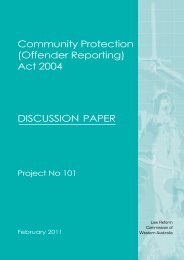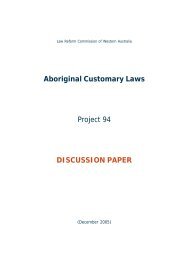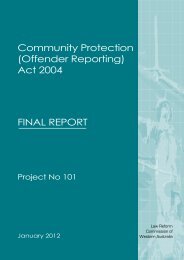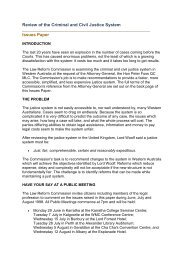Discussion Paper - Law Reform Commission of Western Australia
Discussion Paper - Law Reform Commission of Western Australia
Discussion Paper - Law Reform Commission of Western Australia
You also want an ePaper? Increase the reach of your titles
YUMPU automatically turns print PDFs into web optimized ePapers that Google loves.
who it is said contracted lung cancer as a result <strong>of</strong> inhalation <strong>of</strong> tobacco smoke,<br />
restricting the class <strong>of</strong> plaintiffs to those with a particularly high level <strong>of</strong> tobacco<br />
consumption might facilitate pro<strong>of</strong> <strong>of</strong> causation for that class (restricted, as it will<br />
be, by a previously identified minimum level <strong>of</strong> consumption).<br />
3.34 A closed class will also facilitate requests for further and better particulars <strong>of</strong><br />
the claims by defendants <strong>of</strong> each group member, because the claimants are identified<br />
with greater precision (and are likely to be fewer and more readily identifiable). 52<br />
3.35 However, the effect <strong>of</strong> closed classes is that it effectively converts the statutory<br />
opt-out regime into an opt-in system. 53 Although the courts have allowed this<br />
practice, 54 the justice <strong>of</strong> closed classes has been questioned. 55<br />
3.36 One concern is that members who fail to register might miss out on the<br />
ability to claim if they do not commence proceedings <strong>of</strong> their own or join another<br />
representative action (if available). 56 For a further discussion <strong>of</strong> the tension between<br />
closed classes and the opt-out and an opt-in system, see Chapter 4.<br />
Proceeding with a claim against multiple respondents<br />
3.37 One <strong>of</strong> the key distinctions in the federal and Victorian legislative schemes,<br />
as opposed to the New South Wales scheme, relates to the ability to proceed in a<br />
representative action against multiple respondents.<br />
3.38 In the federal and Victorian schemes, where one applicant is suing multiple<br />
respondents on behalf <strong>of</strong> a group then that applicant must have a claim against<br />
each respondent. 57 The requirement that the claims be against the same respondent<br />
becomes complex when there are multiple respondents. There are conflicting<br />
authorities on the question whether every group member must have a claim against<br />
each respondent. These authorities may be summarised as follows: 58<br />
(a)<br />
(b)<br />
(c)<br />
(d)<br />
In Nixon v Phillip Morris (<strong>Australia</strong>) Pty Ltd, 59 Wilcox J (following his decision<br />
in Symington v Hoechst Schering Agrevo Pty Ltd 60 ) said that all applicants<br />
must have a claim against each respondent. In the subsequent appeal, 61 the<br />
applicants conceded this point.<br />
In Bray v F H<strong>of</strong>fman-La Roche Ltd, 62 two judges held that there was no such<br />
requirement.<br />
Kiefel J in Milfull v Terranora Lakes County Club Ltd (in Liq) 63 followed the<br />
decision in Bray.<br />
However, in Johnstone v HIH Insurance Ltd, 64 the trial judge followed the<br />
Philip Morris decision taking the comments in Bray as obiter only.<br />
52. Meaden v Bell Potter Securities Limited [2011] FCA 136.<br />
53. King & Wood Mallesons, Class Actions in <strong>Australia</strong>: The year in review 2011 (2011) 8.<br />
54. Multiplex Funds Management Ltd v P Dawson Nominees Pty ltd (2007) 164 FCR 275.<br />
55. King & Wood Mallesons, Class Actions in <strong>Australia</strong>: The year in review 2011 (2011) 9.<br />
56. See, eg, Thomas v Powercor <strong>Australia</strong> limited [2011] VSC 614, [31]–[35], class action arising from 2009 Victorian bushfires.<br />
57. Symington v Hoechst Schering Agrevo Pty Ltd (1997) 78 FCR 164, 166.<br />
58. For the full discussion <strong>of</strong> these conflicting Full Court <strong>of</strong> the Federal Court authorities, see Grave D & Adams K, Class Actions in <strong>Australia</strong><br />
(Sydney: <strong>Law</strong>book Co, 2005) 103–13.<br />
59. (1999) 95 FCR 453.<br />
60. (1997) 78 FCR 164, 167.<br />
61. Philip Morris (<strong>Australia</strong>) Ltd v Nixon [2000] 170 ALR 487.<br />
62. (2003) 130 FCR 317.<br />
63. (2004) 214 ALR 228.<br />
64. [2004] FCA 190.<br />
30 <strong>Law</strong> <strong>Reform</strong> <strong>Commission</strong> <strong>of</strong> <strong>Western</strong> <strong>Australia</strong> – Representative Proceedings : <strong>Discussion</strong> <strong>Paper</strong>








